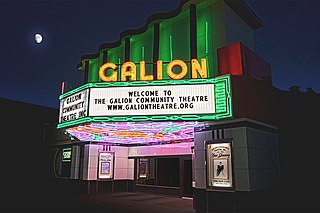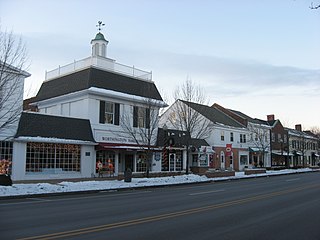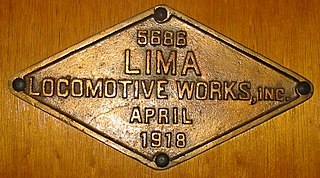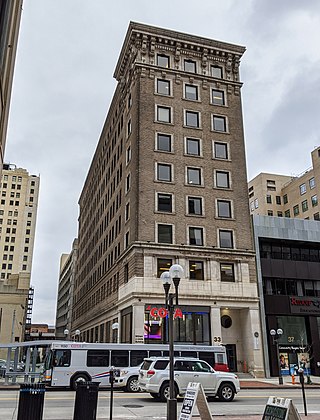
A bogie is a chassis or framework that carries a wheelset, attached to a vehicle—a modular subassembly of wheels and axles. Bogies take various forms in various modes of transport. A bogie may remain normally attached or be quickly detachable. It may include a suspension component within it, or be solid and in turn be suspended ; it may be mounted on a swivel, as traditionally on a railway carriage or locomotive, additionally jointed and sprung, or held in place by other means.

Galion is a city in Crawford, Morrow, and Richland counties in the U.S. state of Ohio. The population was 10,453 at the 2020 census. Galion is the second-largest city in Crawford County after Bucyrus.

Worthington is a city in Franklin County, Ohio, United States, and is a northern suburb of Columbus. The population in the 2020 Census was 14,786. The city was founded in 1803 by the Scioto Company led by James Kilbourne, who was later elected to the United States House of Representatives, and named in honor of Thomas Worthington, who later became governor of Ohio.

Lima Locomotive Works was an American firm that manufactured railroad locomotives from the 1870s through the 1950s. The company took the most distinctive part of its name from its main shop's location in Lima, Ohio. The shops were located between the Erie Railroad main line, the Baltimore & Ohio's Cincinnati-Toledo main line and the Nickel Plate Road main line and shops.

Marion Power Shovel Company was an American firm that designed, manufactured and sold steam shovels, power shovels, blast hole drills, excavators, and dragline excavators for use in the construction and mining industries. The company was a major supplier of steam shovels for the construction of the Panama Canal. The company also built the two crawler-transporters used by NASA for transporting the Saturn V rocket and later the Space Shuttle to their launch pads. The company's shovels played a major role in excavation for Hoover Dam, the Holland Tunnel and the extension of the Number 7 subway line to Main Street in Flushing, Queens.

James Kilbourne was an American surveyor, politician from Ohio, and Episcopalian clergyman. He served two terms in the United States House of Representatives from 1813 to 1817.

BEML Limited, formerly Bharat Earth Movers Limited, is an Indian public sector undertaking which manufactures a variety of heavy equipment, such as that used for earth moving, railways, transport and mining. It is headquartered in Bangalore. BEML is Asia's second-largest manufacturer of earth moving equipment. Its stock trades on the National Stock Exchange of India under the symbol "BEML", and on the Bombay Stock Exchange under the code "500048".

Worthington Kilbourne High School (WKHS) is a public school located in Columbus, Ohio, United States, and is part of the Worthington City School District. Kilbourne was named after James Kilbourne, the founder of the city of Worthington. The school colors are black and royal blue and a gray wolf named "Lobo" is the mascot. The current principal is Aric Thomas.

The Warner & Swasey Company was an American manufacturer of machine tools, instruments, and special machinery. It operated as an independent business firm, based in Cleveland, from its founding in 1880 until its acquisition in 1980. It was founded as a partnership in 1880 by Worcester Reed Warner (1846–1929) and Ambrose Swasey (1846–1937). The company was best known for two general types of products: astronomical telescopes and turret lathes. It also did a large amount of instrument work, such as equipment for astronomical observatories and military instruments The themes that united these various lines of business were the crafts of toolmaking and instrument-making, which have often overlapped technologically. In the decades after World War II, it also entered the heavy equipment industry with its acquisition of the Gradall brand.

Italian Village is a neighborhood in Columbus, Ohio, that contains an array of residential, commercial, and industrial buildings. It is a designated historic district, known for its historical and cultural preservation. The building types and architecture reflect Italian influence. With its parks and preserved historic homes, Italian Village has the highest home value appreciation in Columbus.

The Euclid Company of Ohio was a manufacturer which specialized in heavy equipment for earthmoving, particularly dump trucks, loaders and wheel tractor-scrapers. It operated in the US from the 1920s to the 1950s, when it was purchased by General Motors. The firm was later bought by Hitachi Construction Machinery.

The Ohio Railway Museum is a railway museum that was founded in 1948. It is located in Worthington, Ohio, near Columbus, Ohio.

Crown Equipment Corporation is a privately held American manufacturer of powered industrial forklift trucks based in Ohio. The fifth-largest such manufacturer, Crown had $4.69 billion in worldwide sales revenue for fiscal year 2022. The company was founded in 1945.
Belmont Glass Company, also known as the Belmont Glass Works, was one of Ohio's early glassmaking companies. It was named after Belmont County, Ohio, where the plant was located. The firm began operations in 1866 in a riverfront village along the east side of the county, which is known as Bellaire. At that time, the community had resource advantages that made it an attractive site for glassmaking. Bellaire's location at the intersection of the Ohio River, the National Road, and two railroads meant it had an excellent transportation infrastructure. Fuel necessary for the glassmaking process was also readily available, since Belmont County was part of the eastern Ohio coal region. Bellaire also had a workforce with glassmaking expertise located less than five miles away, since glass had been produced in Wheeling, West Virginia, since the 1820s.
Novelty Glass Company of Fostoria was one of over 70 glass manufacturing companies that operated in northwest Ohio during the region's brief Gas Boom in the late 19th century. The company made bar goods, stemware, and novelties. Organization of the firm began late in 1890, with banker Rawson Crocker as president and veteran glass man Henry Crimmel as plant manager. Production started in February 1891. The plant was built on the site of the former Buttler Art Glass Company, which had been destroyed by fire in 1889.
Milo-Grogan is a neighborhood of Columbus, Ohio. The neighborhood was settled as the separate communities of Milo and Grogan in the late 1870s. Large-scale industrial development fueled the neighborhood's growth until the 1980s, when the last factories closed. The community has received urban renewal efforts in recent years fueled by the Columbus Department of Development and Milo-Grogan Area Commission.

Belarus had third by volume part of automotive industry of the Soviet Union with near 40,000 annual production. Since that times Belarus specializes on production of own designed superheavy, heavy and middle trucks mainly plus post-Soviet developed buses, trolleybuses and trams. Auto manufacturers in Belarus include MAZ, BelAZ and Neman.
Columbus, the capital city of Ohio, was founded on the east bank of the Scioto River in 1812. The city was founded as its capitol, beside the town of Franklinton, since incorporated into Columbus. The city's early history was gradual, as residents dealt with flooding and cholera epidemics, and the city had few direct connections to other cities. This led creation of a feeder canal, and later, freight and passenger railroads. The city became known for its industry and commercial businesses into the 20th century, though it experienced a lull in development in the late 20th century. In the 21st century, Columbus has been increasingly revitalized, led by parks projects, new developments, and efforts to beautify individual neighborhoods. This was of great impact to Ohio's economy and development. Also the positive outcome left a great legacy for the next generation of future leaders and rulers in Columbus.
Great Dane, formerly known as Great Dane Trailers, is a Chicago, Illinois based manufacturer of truck dry van, refrigerated van and flatbed semi-trailers. Established in 1900 by J.P. Wheless and T.H. McMillan as the Savannah Blowpipe Company in Savannah, Georgia, it has gone on to become one of the world's largest manufacturers of commercial truck trailers.

The William J. Lhota Building is a historic office building on High Street in downtown Columbus, Ohio. The building is primarily known as the headquarters of the Central Ohio Transit Authority (COTA), the city's transit system. It is owned by COTA, with some office space leased to other organizations. The building was added to the National Register of Historic Places as part of the High and Gay Streets Historic District in 2014.
















